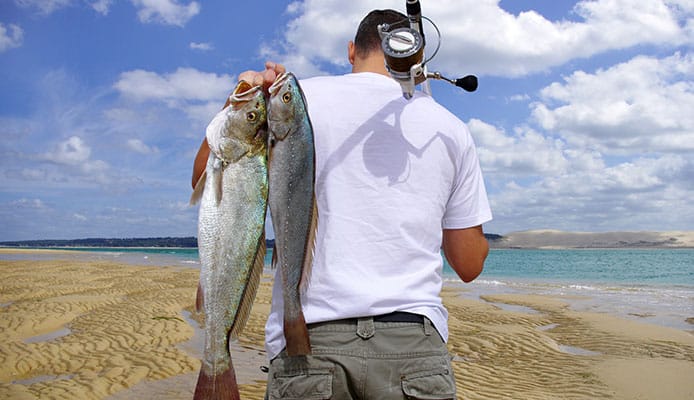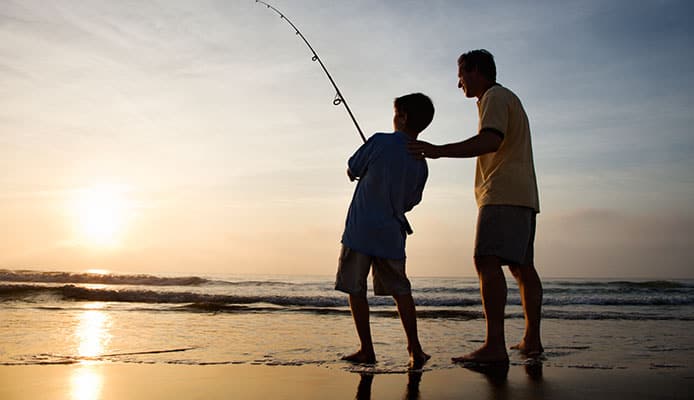
More and more anglers, especially those living in coastal towns or have access to beaches, are getting into surf fishing. And why not? Surf fishing allows anglers to catch a variety of coastal wonders, and the challenges of this particular environment offer a different kind of experience for those who are getting bored with calm lakes and rivers. As engaging as it sounds though, surf fishing isn’t always as easy as it is enjoyable. Remember, it’s a whole different environment, which means that you’ll have to level up if you’re going to be successful out there. Fortunately, surf fishing is a skill that can be learned and developed over time, and one of the very first things that you need to work on is your surfcasting. Different anglers employ different surfcasting techniques, and here are some of them.
The Off the Ground Cast
The Off the Ground cast (OTG) is considered a “Power Cast” as it applies a hellacious force on your line and allows you to cast it farther. Despite that, it is also one of the easiest surfcasting technique to learn and can be employed in normal surf fishing conditions. This casting technique does not require the use of any special rod or reel as it works equally well with your conventional tackle. A key point to remember when employing this surfcasting technique is proper timing. Most people either release too early or too late, which then results in a “shank” cast to the right or left.
The Pendulum Cast
The pendulum cast is very powerful as it imparts incredible speed on the lure causing it to fly from the shore much farther than a conventionally cast lure. That said, many pro surf anglers use this technique, and you can see many top casters use the pendulum cast in long casting tournaments.
There are different ways to execute the “pendulum” cast. More often than not, many anglers eventually end up crafting their own version of this technique, one that works best for their particular needs. For example, some surf anglers usually allow for fishing lines that are half their rod’s length, while others prefer to use twice as much. There’s no issue with tweaking or modifying this particular technique since the best casting technique will always be the one that works best for you.
One problem that beginning surf anglers usually encounter while learning this surfcasting technique is timing. More often than not, they tend to bring to power too early which then results in killing the cast. As such, it is best to learn how to control the cast by working your casting form and not swinging your body and arms wildly in awkward positions. This will take a little practice to get used to and should become easier the more you do it.
The Overhead Cast
Many surf anglers would agree that the overhead cast is one of the easiest to learn and improve upon. Also, this is the kind of surfcasting technique that you’ll want to use whenever you’re in a crowded area because compared to other surfcasting techniques, this is deemed to be the safest to execute. The best part is that this surfcasting technique lends itself well to a variety of bait or lure imaginable.
Just like with other surfcasting techniques, beginning surf anglers usually encounter problems when learning the overhead cast. For instance, many beginning surf anglers make the mistake of pushing with their ‘following’ hand instead of pulling with their ‘leading’ hand. Concerning the overhead cast, it is important to remember that the pull generated by the ‘lead’ hand is what allows the cast to create that forceful speed and add distance to the cast.
You might also like: The World’s Most Dangerous Fish Of The Sea
Applying Surfcasting Techniques
Aside from the specific notes to remember when applying the above-mentioned surfcasting techniques, here are some other tips that can help improve your casts.
- Surfcasting is indeed challenging to learn, and the only way to become good at it is through practice. Not even the best surfcasting rods will help you to cast hundreds of yards if you don’t practice.
- Give the above surfcasting techniques a try and choose one which you are most comfortable with. More often than not, one surfcasting technique is all you need to land that magnificent coastal fish waiting in the water.
- Start slowly and safely. Just cast at a normal pace, and as you get used to the technique, you can start putting more and more backbone into your casts.
- Always remember to maintain proper form and posture when executing any of the surfcasting techniques mentioned above. A successful cast is depended more on the movement of your body (and some physics) than on how large your biceps are.
- Many beginning surf anglers tend to have this mindset that they need to be able to cast farther than anyone else. After all, the farther you can cast the bigger the potential for you to cover more water. However, it’s not always about how far you can throw your line. More often than not, you’d be a more successful surf angler if you can accurately and consistently cast to those areas where the fish are holding.
- Some surf anglers will recommend that you use lures that have aerodynamic shapes. Accordingly, lures shaped this way can cut through the air more efficiently and are thus able to retain more of their speed and fly farther. Of course, this isn’t always possible especially when you consider the type of lure or bait that the fish you’re hunting will be attracted to, but when presented with the opportunity, it would be wise to follow this advice.
- Safety is and should always be the main concern for anyone who is engaged in surfcasting. Fishing lines do break and lures and hooks can start flying in all sorts of directions if you’re not careful. If you’re still learning how to fish from the surf, it is best to have a mentor with you and choose a less crowded and spacious area to practice your casting technique.
Globo Surf Overview
Surfcasting can be challenging, but it can also be exciting once you start reeling in those large predatory sea wonders and game fish. But as mentioned, you first need to learn and develop your surfcasting techniques so that you can rocket your lure far enough to reach those break zones where these marine creatures are holding. So what are you waiting for? Grab your surfcasting gear, head out to the beach and start throwing that lure towards the horizon. Remember that just like any other skill, you can only get better with surfcasting with practice.


